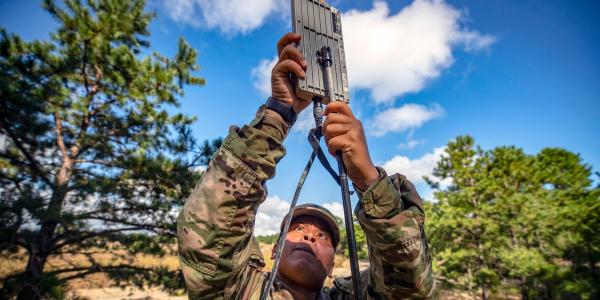Back to Basics May Be the Best Path for Tactical Networking
As the U.S. Army designs the next generation of tactical communications, it may find that battlefield networking’s reach exceeds its grasp. Plans for future military tactical communications networks may be more ambitious than actually possible, even with anticipated technology advances. And these more complicated networks are threatened by increasingly sophisticated adversaries bent on denying U.S. forces their network centricity.
The solution is to eschew the newest mobile technologies in favor of ensuring a minimum data rate in whatever battlefield conditions the Army faces, says Larry Goeller, research staff member at the Institute for Defense Analyses (IDA). Goeller emphasizes that his opinions do not necessarily represent those of IDA. He relates that much of his perspective is gleaned from feedback he received from personnel attending the courses he taught at AFCEA. Combined with his own expertise, this provides him with a full-spectrum perspective.
Goeller describes the cancellation of the Warfighter Information Network-Tactical (WIN-T) as huge, and he decries the capabilities of the Mobile User Objective System (MUOS) satellite constellation. Engineers have had problems with its waveform, which has not yet been declared operational, and its future is uncertain, he states. Other technological advances have not proved their worth and may actually stand in the way of assured connectivity.
“The software-defined radio idea is a dead end,” he declares. “It’s time to stop and try something else.” A lot of existing radios support multiple waveforms, which avoids silos. But this waveform support is done through hardware instead of employing a software-defined solution. Another dead end is mobile ad hoc networking, as in MANET, he adds.
Technical implementation problems are the biggest obstacle to battlefield communications and networking, he says. “The Army tried to take the Internet and deploy it to the battlefield,” he notes. “The problem with that is, the way the Internet has grown, it is totally dependent on fiber optics.” He relates that the scaling of optical connectivity for the Internet over the past 20 years is as great as it was for memory chips in that time frame. Fiber optics offers almost infinite capacity, and it is involved in commercial applications such as cellular telephony, where it serves to carry traffic from cell towers into the infostructure.
But tactical deployed warfighting forces have no fiber optic backbone to tap into. MANET offered that everyone would be a cell tower, but the absence of fiber lessened that concept’s effectiveness. “The problem with having every HUMVEE or soldier relay stuff around is that you don’t have the fiber optic connectivity—you have maybe a megahertz of bandwidth,” he points out.
The commercial world, on the other hand, can increase wireless bandwidth because it has optical fiber backing up the network, he states. That is exactly what the battlefield lacks.
“The physical layer associated with tactical communications doesn’t have fiber optics,” Goeller says. “You have to start from there. A tactical network must live in basically a fiber-optic-less world, and that has huge implications for everything else.”
Increasing the tactical data rate also requires tradeoffs, he continues. Jam resistance drops as data rate increases, as does low probability of detection. “If you’re transmitting all the time, people can find you,” Goeller points out. Size, weight and power also increase with a greater data rate, which in turn enlarges the logistical footprint. “If a soldier is trying to transmit and act like a relay tower over 10 miles, he has to carry batteries to support that on his back instead of ammo or water,” he says.
And network centricity trades off with network security. “The more people you want to be able to contact and be able to exchange information with, the less stovepiped you want to be. That trades with keeping your network secure—keeping bad guys out.”
The answer to the future networking challenge may be to look back, Goeller offers. The Army should approach its tactical communications needs as if it were the 1970s, when fiber optics were not available. “If you want survivability and network connectivity, lower your capacity,” he suggests.
The key to meeting the tactical communications challenge may lie in lower data rates. Instead of planning for the highest potential data rates, the Army should establish a floor for the lowest needed data rates and build up from there. This data rate floor should focus on the minimum capacity—what the soldier needs to do his or her job. “What is the minimum you actually need?” Goeller asks.
Using lower frequencies such as VHF will work better too, he adds. They travel better, as users can employ large dipole antennas with a 10-mile range with a reasonable amount of power.
For some capabilities, such as voice, compression may reduce the need for higher data rates. Or, perhaps voice will not be necessary, he suggests. “Can soldiers text during combat? Is that an unreasonable expectation? Can you have a device that translates voice into text—ASCII or UNICODE—and then just sends out a message? What could these soldiers actually talk about on the radio that they actually need the radio for?” he proposes.
And despite MUOS shortcomings, satellites may offer a solution. “If you’re on the battlefield and all you have is RF, then what do you do? The nice thing about satellites is that they’re up instead of sideways,” he says. Satellites are hard to attack, he offers, and attempts to jam them makes the jammer a target. The expensive, high-power-consumption gear is taken off the soldier’s back and placed in orbit.
A new satellite constellation probably will need to be in geosynchronous orbit, Goeller says. Four orbiters would last 15 years, and even latency issues would not override the advantage they would provide over low-earth-orbit counterparts. Ground stations would control each satellite and apportion satellite capacity directly to areas below where it is needed.
Goeller says that many young people in the Army today lose sight of what really matters when it comes to tactical communications. “Don’t focus so much on how cool the equipment is,” he advises. “Instead, [focus on] what do you need it to do? Technology is wonderful, but it’s a means to an end. Keep your eye on the end.”





Comment
25C/25W/11B here. I'm saving
25C/25W/11B here. I'm saving this and sharing amongst my peers. If it's alright, should we send our thoughts/ideas? Network centric has all but made the ground rto obsolete and we use HF as a means of reliable voice/data. With that being said, are the folks in the think tanks listening? Thanks, Jim
Good on you for sharing this
Good on you for sharing this with your peers. Don't ask if you can send your thoughts/ideas -- do it. Anyone worth their salt will welcome them and anyone who doesn't is a waste of flesh and has no place serving.
A couple of thoughts. First,
A couple of thoughts. First, the concepts of SDR and MANET are hardly dead ends, but what is a limiting factor is a lack of definition of exactly what the tactical network should carry. First and foremost, it's NOT the Internet, but a network to support a specific task/purpose. It's possible to overload it quickly and that lesson is not obvious to early implementers and likely also not to commanders. The functional loss of the RTO is a problem but one that can be addressed: HF needs to still be considered a redundant element in the mix.
Goeller offers a solution that looks skyward, to satellites. But that path has problems. At least three countries have demonstrated the ability to destroy an orbiting satellite, and the potential adverse impacts from seeing as few as 4-5 satellites in low earth orbit simultaneously destroyed could wreak havoc on the remaining LEO birds. Satellites in geosynchronous orbit generally are difficult to access unless you can direct an antenna specifically to the bird. And, while bandwidth may be available on the satellite overall, what restrictions will command place to make sure they can talk to everyone they want to talk to, limiting real-time utility?
I suspect MANET, or variations thereof, will reemerge and be refined. And I am afraid I don't see the demise of the software defined radio. It, and its myriad waveforms are complex, but they're a significant benefit when the new possibilities and waveforms are properly implemented in the field.
If legacy mesh networks are
If legacy mesh networks are replaced with MIMO MANET solutions using the same spectrum resources but delivering higher throughput, how is this a dead end? DoD should have invested in their own Low or Mid Earth Orbit constellation with the $7.5B wasted on MUOS or should I say DAMA 2.0. The only way UHF Satcom was combat effective was with 25KHz clear channels on UFO and only cool guys got those. M hops to another radio I can 100 meters away is ridiculous and JENM, don't get me started.
We need to think in terms
We need to think in terms beyond simple SATCOM, and consider how we'll handle HEMP. I'm concerned that space will suddenly become our denied communications environment and we'll have to figure out how to deploy other assets to fill the gap. That's not an impossible task, but a LEO or MEO HEMP double-tap could disable or degrade 90% of the satellites in that range. Launching new constellations takes time, even if we had 'em queued up at the launch facility, and getting them on-station is another delay.
I don't deny MUOS and DAMA 2.0 didn't perform well and were essentially niche. Where's out outside the box thinking?
We are making great progress
We are making great progress with anti-jam, software defined, Mobile Ad Hoc Networks (MANET) with beam steering, beam nulling, antennas. Future unmanned systems will have a heavy reliance on reliable and secure high bandwidth comms. The government should not be in the business of trying to develop products. It never works out well (MUOS, Win-T, SRW, WNW, etc)
Comments